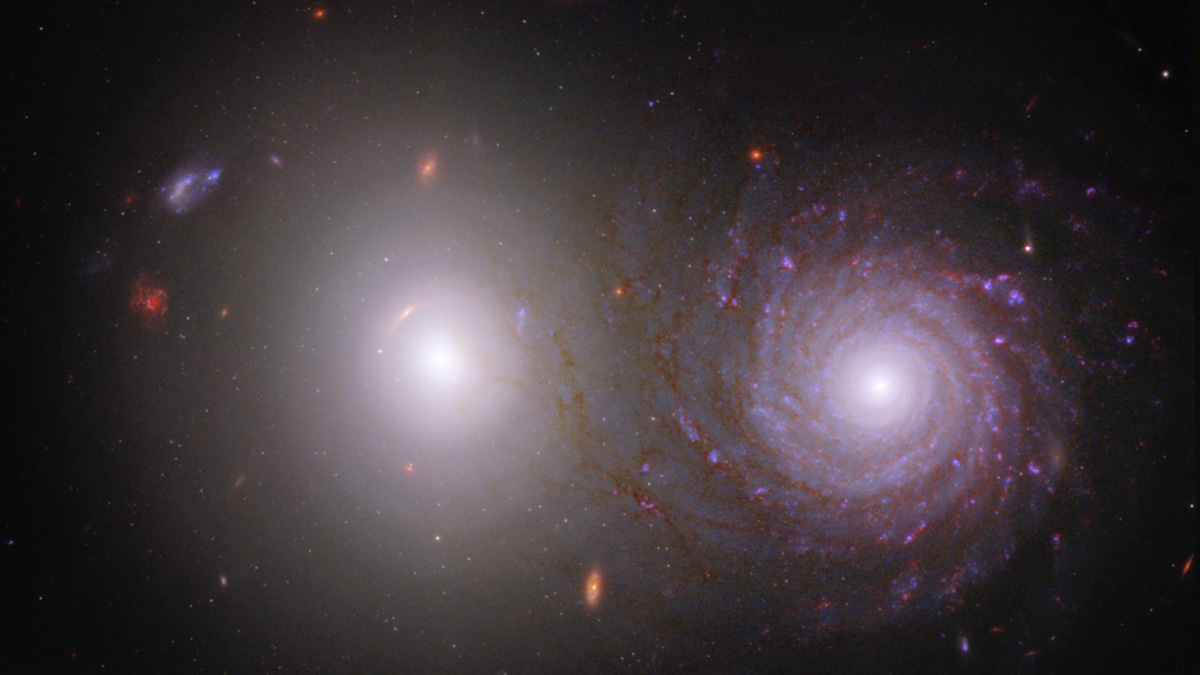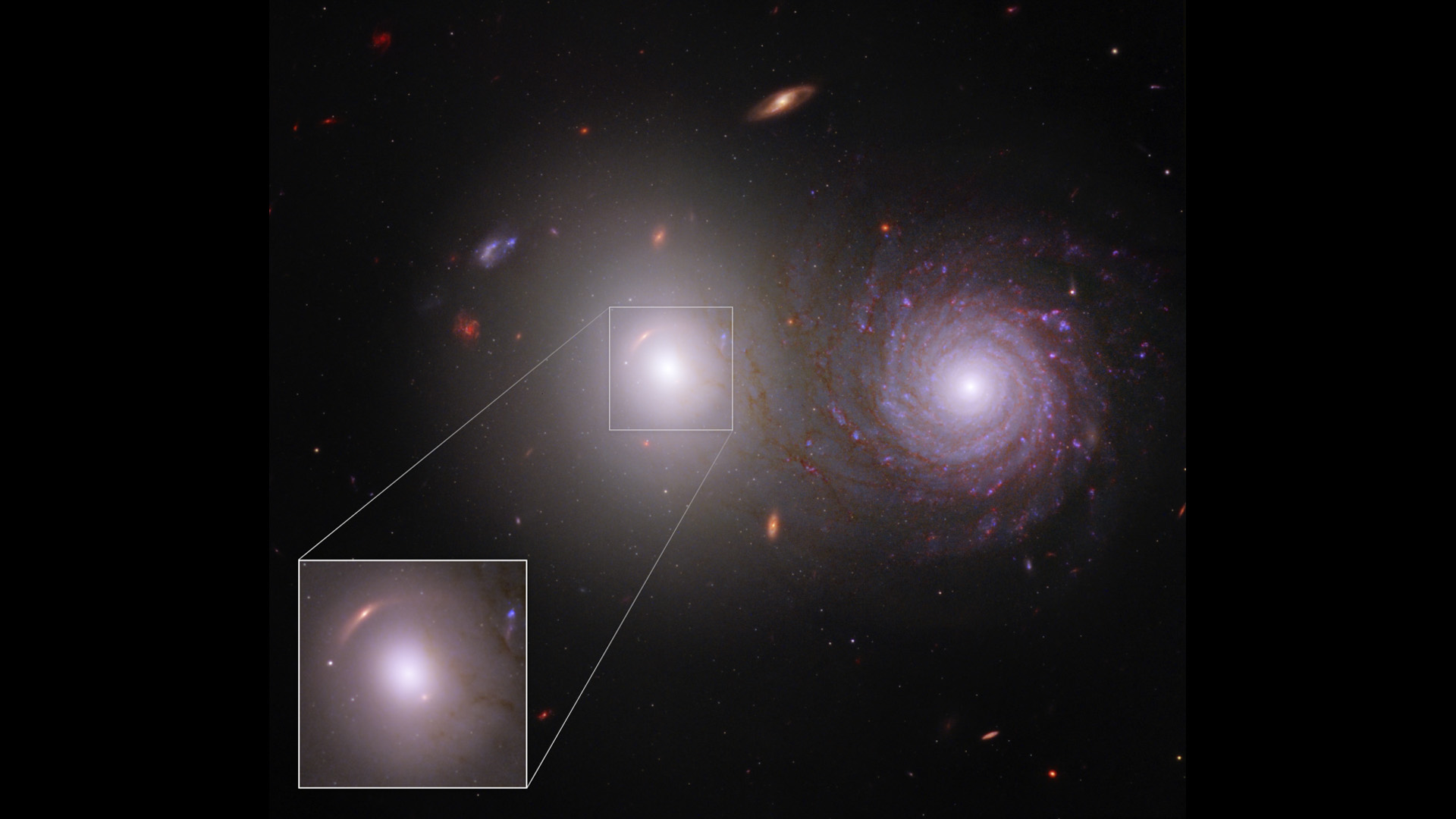James Webb Space Telescope and Hubble team up to peer through cosmic dust
The combination of the two telescopes' super powers reveals previously unseen features of a pair of distant galaxies.

Astronomers have combined observations from the James Webb and Hubble Space Telescopes to get a better grasp of how interstellar dust obscures the view of distant galaxies.
The newly released image, capturing two galaxies that appear close to each other, combines the infrared measurements taken by the James Webb Space Telescope with the visible and ultraviolet light imaging done by the Hubble Space Telescope.
In the image, the two galaxies known under the common name VV 191 appear to interact with each other, but they are actually quite distant. Light from the simple elliptical galaxy seen on the left of the image shines through the complex spiral galaxy on the right, which is located closer to Earth. The light from the background galaxy has to pass through the outer reaches of the spiral arms of the galaxy in the front, which can be distinguished in the image thanks to Webb's infrared vision. Features captured by Webb are represented by green, yellow and reddish hues in this image, while Hubble's observations are displayed in shades of blue.
Related: Iconic James Webb Space Telescope images get X-ray vision boost
"We got more than we bargained for by combining data from NASA's James Webb Space Telescope and NASA's Hubble Space Telescope!" Rogier Windhorst, an astronomer at Arizona State University and a lead author of the new research paper, said in a NASA statement. "Webb's new data allowed us to trace the light that was emitted by the bright white elliptical galaxy, at left, through the winding spiral galaxy at right, and identify the effects of interstellar dust in the spiral galaxy."
Tracking the distribution of dust in galaxies helps astronomers understand how this dust alters the brightness and color of background objects, Windhorst added. Moreover, regions with high concentrations of dust and gas are likely areas where new stars and planets form, which makes them particularly attractive targets for astronomers.
When analyzing this image, astronomers made a bonus discovery: They found an unknown and very distant galaxy that was made visible thanks to the combination of Webb's observational superpowers and an effect known as gravitational lensing, by which extremely massive foreground objects bend light, acting like a magnifying glass for faint bodies in the background
Get the Space.com Newsletter
Breaking space news, the latest updates on rocket launches, skywatching events and more!

The unknown galaxy, which has not yet been named, can be seen on the left of the white elliptical galaxy as an arced streak of orange light. In fact, the lensed galaxy is visible twice in this image, thanks to the duplicating effect that comes with gravitational lensing. The second apparition, however, is much harder to spot. The galaxy shines as a small, dim dot at 4 o'clock in the zoomed-in inset.
"These images of the lensed galaxy are so faint and so red that they went unrecognized in Hubble data, but are unmistakable in Webb's near-infrared image," Windhorst said in the statement. "Simulations of gravitationally lensed galaxies like this help us reconstruct how much mass is in individual stars, along with how much dark matter is in the core of this galaxy."
VV 191 was selected as a target for Webb's observations from about 2,000 galaxies found in Webb's images by citizen scientists as part of the Galaxy Zoo project. There is more that needs in-depth exploration in this image, Windhorst said. Spiral galaxies of different sizes and colors are scattered in the background, so astronomers have to do more work to understand how far away they are and how much dust they contain.
The observations were described in two as-yet unpublished papers that are available via the online repository Arxiv.
Follow Tereza Pultarova on Twitter @TerezaPultarova. Follow us on Twitter @Spacedotcom and on Facebook.
Join our Space Forums to keep talking space on the latest missions, night sky and more! And if you have a news tip, correction or comment, let us know at: community@space.com.

Tereza is a London-based science and technology journalist, aspiring fiction writer and amateur gymnast. Originally from Prague, the Czech Republic, she spent the first seven years of her career working as a reporter, script-writer and presenter for various TV programmes of the Czech Public Service Television. She later took a career break to pursue further education and added a Master's in Science from the International Space University, France, to her Bachelor's in Journalism and Master's in Cultural Anthropology from Prague's Charles University. She worked as a reporter at the Engineering and Technology magazine, freelanced for a range of publications including Live Science, Space.com, Professional Engineering, Via Satellite and Space News and served as a maternity cover science editor at the European Space Agency.









